Istanbul and Turkey
-
Transportation
Istanbul Ataturk Airport is well-connected with other major airports around the world. Public transportation in Istanbul comprises an extensive bus network, various rail systems, funiculars, taxis and maritime services. Refillable Istanbul Card is the official boarding pass and is accepted in all buses, trams, and ferryboats.
-
Currency
The local currency is the Turkish Lira (TL). Currency can be exchanged at airports, banks, exchange booths and most hotels. You can find the most current conversion rates at Turkish Central Bank's Website.
Major credit cards including MasterCard, Visa, American Express, and Diners are accepted in big hotels, car rental companies and stores.
-
Weather
The average temperature at the end of May through the beginning of June ranges between 18°C / 64 °F and 22 °C /72 °F.
-
Local Time
GMT+2 (GMT = Greenwich Mean Time)
-
Emergency
In case of an emergency in Turkey, please call 112 for emergency services or call 155 for police.
-
Must See Places in Istanbul
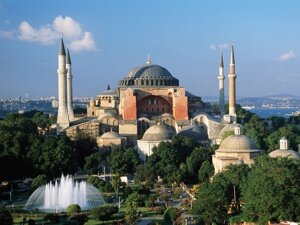 Hagia Sophia (Ayasofya) Museum: Ayasofya is the largest enclosed space in the world which was built in 537 and is still seen as one of the world’s most important architectural monuments. It is a UNESCO World Heritage Site and one of Turkey’s most popular attractions, due to its size, architecture, mosaics and art. It used to be a church for 916 years, then a mosque for 481 years, and has been a museum since 1935.
Hagia Sophia (Ayasofya) Museum: Ayasofya is the largest enclosed space in the world which was built in 537 and is still seen as one of the world’s most important architectural monuments. It is a UNESCO World Heritage Site and one of Turkey’s most popular attractions, due to its size, architecture, mosaics and art. It used to be a church for 916 years, then a mosque for 481 years, and has been a museum since 1935.
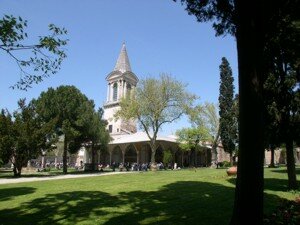 Topkapı Palace: Topkapı Palace was the primary residence of the Ottoman sultans, the administrative and educational center of the state and a setting for royal entertainments for 400 years. As a UNESCO World Heritage Site it is described "the best example[s] of ensembles of palaces of the Ottoman period". It is also the place where the Holy Relics of the Muslim world are exhibited. It is a major tourist attraction today.
Topkapı Palace: Topkapı Palace was the primary residence of the Ottoman sultans, the administrative and educational center of the state and a setting for royal entertainments for 400 years. As a UNESCO World Heritage Site it is described "the best example[s] of ensembles of palaces of the Ottoman period". It is also the place where the Holy Relics of the Muslim world are exhibited. It is a major tourist attraction today.
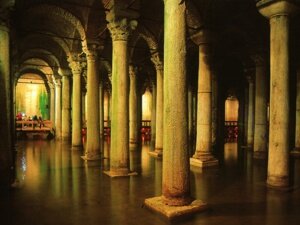 Basilica Cistern: Basilica Cistern was built in the 6th century during the reign of Byzantine Emperor Justinian to provide water for the Great Palace of Constantinople. It kept providing water to The Topkapı Palace in the Ottoman Empire. It has a unique atmosphere with its columns, arches and the two Medusa head, masterpieces of the First Age Art of Statuary; which lies beneath the historical peninsula of Sarayburnu.
Basilica Cistern: Basilica Cistern was built in the 6th century during the reign of Byzantine Emperor Justinian to provide water for the Great Palace of Constantinople. It kept providing water to The Topkapı Palace in the Ottoman Empire. It has a unique atmosphere with its columns, arches and the two Medusa head, masterpieces of the First Age Art of Statuary; which lies beneath the historical peninsula of Sarayburnu.
 Blue Mosque: The Blue Mosque is an historical mosque in Istanbul which was built between 1609 and 1616, during the rule of Sultan Ahmed I. It is named due to the blue tiles adorning the walls of the interior design. It also comprises the tomb of the founder, a madrasa and a hospice, just like many other mosques.
Blue Mosque: The Blue Mosque is an historical mosque in Istanbul which was built between 1609 and 1616, during the rule of Sultan Ahmed I. It is named due to the blue tiles adorning the walls of the interior design. It also comprises the tomb of the founder, a madrasa and a hospice, just like many other mosques.
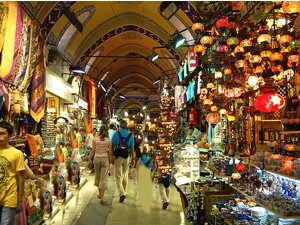 Grand Bazaar: Built in the 15th century, the Grand Bazaar (Kapalıçarşı) is one of the largest covered markets in the world with 60 streets and 5,000 shops. It is famous with its jewelry, hand-painted ceramics, carpets, embroideries, spices, antique shops and architectural beauty. It attracts between 250,000 and 400,000 visitors daily.
Grand Bazaar: Built in the 15th century, the Grand Bazaar (Kapalıçarşı) is one of the largest covered markets in the world with 60 streets and 5,000 shops. It is famous with its jewelry, hand-painted ceramics, carpets, embroideries, spices, antique shops and architectural beauty. It attracts between 250,000 and 400,000 visitors daily.
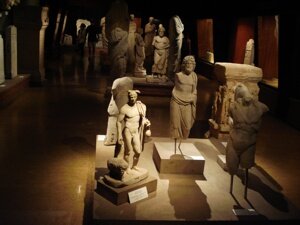 Istanbul Archaeological Museums: The Istanbul Archaeological Museums, is located in Istanbul's Sultanahmet suburb, and comprises of three different museums under the same administration: The Archaeological Museum, the Ancient Orient Museum and Tiled Kiosk Museum. Various artifacts from various civilizations that had left their traces to different periods of the history can be seen in this museum, which is known as one of the 10 most important world-class museums.
Istanbul Archaeological Museums: The Istanbul Archaeological Museums, is located in Istanbul's Sultanahmet suburb, and comprises of three different museums under the same administration: The Archaeological Museum, the Ancient Orient Museum and Tiled Kiosk Museum. Various artifacts from various civilizations that had left their traces to different periods of the history can be seen in this museum, which is known as one of the 10 most important world-class museums.
 Istanbul Mosaic Museum: Istanbul Mosaic Museum was built in the courtyard of the Great Palace of the Byzantine Empire, which is in the Blue Mosque compound today. The mosaics used to decorate the pavement of the Great Palace, which have been dated to AD 450-550, had been discovered partially in good condition. The mosaics which depict scenes of daily life, mythology and nature are stunning in terms of both art and wealth of portrayal scenes.
Istanbul Mosaic Museum: Istanbul Mosaic Museum was built in the courtyard of the Great Palace of the Byzantine Empire, which is in the Blue Mosque compound today. The mosaics used to decorate the pavement of the Great Palace, which have been dated to AD 450-550, had been discovered partially in good condition. The mosaics which depict scenes of daily life, mythology and nature are stunning in terms of both art and wealth of portrayal scenes.
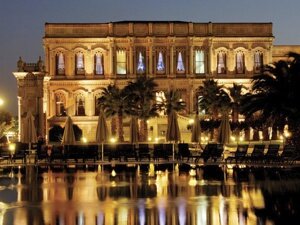 Çırağan Palace: A former Ottoman palace, is now a five-star hotel that is located on the European shore of the Bosporus. It is used for important social events today. The palace was built by Sultan Abdülâziz between 1863 and 1867. The inner walls and the roof were made of wood, the outer walls of colorful marble with a baroque style and soft colors.
Çırağan Palace: A former Ottoman palace, is now a five-star hotel that is located on the European shore of the Bosporus. It is used for important social events today. The palace was built by Sultan Abdülâziz between 1863 and 1867. The inner walls and the roof were made of wood, the outer walls of colorful marble with a baroque style and soft colors.
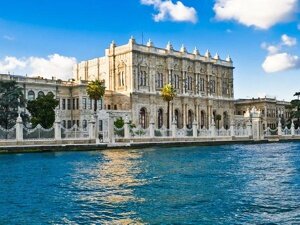 Dolmabahçe Palace: Dolmabahçe Palace, located on the European coastline of the Bosphorus strait, was built between the years 1843 and 1856. It served as the main administrative center of the Ottoman Empire from 1856 to 1922, apart from a 22-year interval (1887–1909) in which Yıldız Palace was used. The design creates a new sythesis which contains elements from the Baroque, Rococo and Neoclassical styles, blended with traditional Ottoman architecture.The construction cost five million Ottoman gold coins, 35 tonnes of gold. Fourteen tonnes of gold in the form of gold leaf were used to gild the ceilings of the palace.
Dolmabahçe Palace: Dolmabahçe Palace, located on the European coastline of the Bosphorus strait, was built between the years 1843 and 1856. It served as the main administrative center of the Ottoman Empire from 1856 to 1922, apart from a 22-year interval (1887–1909) in which Yıldız Palace was used. The design creates a new sythesis which contains elements from the Baroque, Rococo and Neoclassical styles, blended with traditional Ottoman architecture.The construction cost five million Ottoman gold coins, 35 tonnes of gold. Fourteen tonnes of gold in the form of gold leaf were used to gild the ceilings of the palace.
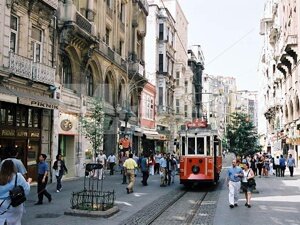 İstiklal Street: Istiklal Street is one of the most famous streets in Istanbul, visited by nearly 3 million people in a single day over the course of weekends. As a 24 hours live zone it houses exquisite boutiques, music stores, bookstores, art galleries, cinemas, theatres, libraries, cafés, historical patisseries, chocolateries and restaurants.
İstiklal Street: Istiklal Street is one of the most famous streets in Istanbul, visited by nearly 3 million people in a single day over the course of weekends. As a 24 hours live zone it houses exquisite boutiques, music stores, bookstores, art galleries, cinemas, theatres, libraries, cafés, historical patisseries, chocolateries and restaurants.
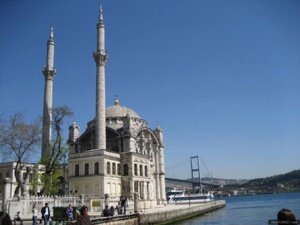 Ortaköy Square: It is located in the middle of the European bank of the Bosphorus. It is famous with its street galleries exhibiting mostly handmade artcrafts and kumpir which is baked potato served with a variety of sauces and toppings. Ortaköy was a symbol of tolerance hosting different nations and cultures together in peace, in the Ottoman era and today the neighbourhood still hosts many different religious (Muslim, Jewish, Orthodox, and other Christian) structures.
Ortaköy Square: It is located in the middle of the European bank of the Bosphorus. It is famous with its street galleries exhibiting mostly handmade artcrafts and kumpir which is baked potato served with a variety of sauces and toppings. Ortaköy was a symbol of tolerance hosting different nations and cultures together in peace, in the Ottoman era and today the neighbourhood still hosts many different religious (Muslim, Jewish, Orthodox, and other Christian) structures.
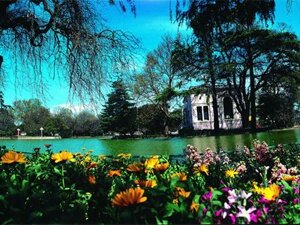 Yıldız Park: Yıldız Park is a historical park, once part of the imperial garden of Yıldız Palace, which is located in Beşiktaş district of Istanbul. Currently Yıldız Park is a beautiful garden complex with a very large park of flowers, plants and trees and that is why it is a popular picnic place. Park grounds offer panoramic views of the Bosphorus. Two beautiful old pavilions offer the chance to have breakfast or lunch within the beauty of nature.
Yıldız Park: Yıldız Park is a historical park, once part of the imperial garden of Yıldız Palace, which is located in Beşiktaş district of Istanbul. Currently Yıldız Park is a beautiful garden complex with a very large park of flowers, plants and trees and that is why it is a popular picnic place. Park grounds offer panoramic views of the Bosphorus. Two beautiful old pavilions offer the chance to have breakfast or lunch within the beauty of nature.
 Pierre Loti Hill: The famous cafe on top of the hill entitled with the name of Pierre Loti, a famous French writer whose real name was Julien Viaud. He lived in Istanbul for long years and was a real Istanbul lover. He admired the Ottoman culture and life style and used to visit this café when he was in İstanbul.The historical cafe is the most ideal place to watch the perfect view of Golden Horn with a tranquil atmosphere.
Pierre Loti Hill: The famous cafe on top of the hill entitled with the name of Pierre Loti, a famous French writer whose real name was Julien Viaud. He lived in Istanbul for long years and was a real Istanbul lover. He admired the Ottoman culture and life style and used to visit this café when he was in İstanbul.The historical cafe is the most ideal place to watch the perfect view of Golden Horn with a tranquil atmosphere.